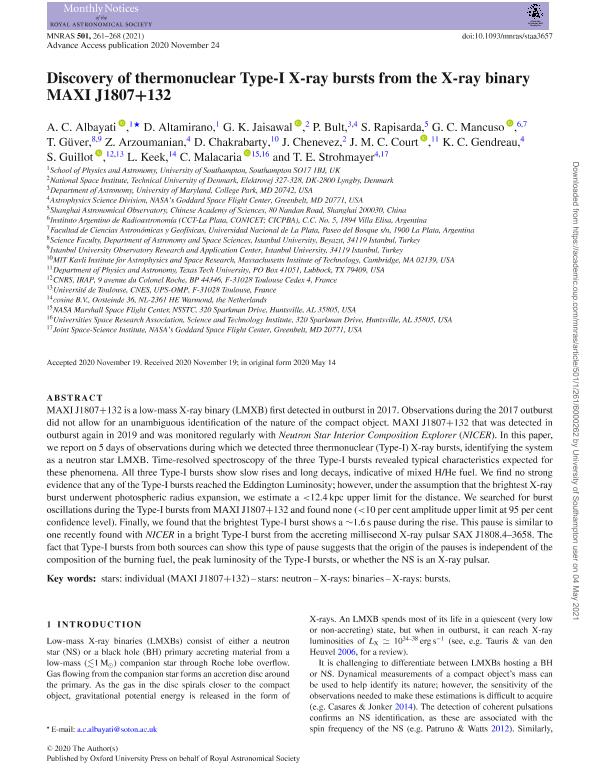Mostrar el registro sencillo del ítem
dc.contributor.author
Albayati, A. C.
dc.contributor.author
Altamirano, D.
dc.contributor.author
Jaisawal, G. K.
dc.contributor.author
Bult, P.
dc.contributor.author
Rapisarda, S.
dc.contributor.author
Mancuso, Giulio Cesare

dc.contributor.author
Güver, T.
dc.contributor.author
Arzoumanian, Z.
dc.contributor.author
Chakrabarty, D.
dc.contributor.author
Chenevez, J.
dc.contributor.author
Court, J. M. C.
dc.contributor.author
Gendreau, K. C.
dc.contributor.author
Guillot, S.
dc.contributor.author
Keek, L.
dc.contributor.author
Malacaria, C.
dc.contributor.author
Strohmayer, T. E.
dc.date.available
2021-07-01T16:29:41Z
dc.date.issued
2021-02
dc.identifier.citation
Albayati, A. C.; Altamirano, D.; Jaisawal, G. K.; Bult, P.; Rapisarda, S.; et al.; Discovery of thermonuclear Type-I X-ray bursts from the X-ray binary MAXI J1807+132; Wiley Blackwell Publishing, Inc; Monthly Notices of the Royal Astronomical Society; 501; 1; 2-2021; 261-268
dc.identifier.issn
0035-8711
dc.identifier.uri
http://hdl.handle.net/11336/135287
dc.description.abstract
MAXI J1807+132 is a low-mass X-ray binary (LMXB) first detected in outburst in 2017. Observations during the 2017 outburst did not allow for an unambiguous identification of the nature of the compact object. MAXI J1807+132 that was detected in outburst again in 2019 and was monitored regularly with Neutron Star Interior Composition Explorer(NICER). In this paper, we report on 5 days of observations during which we detected three thermonuclear (Type-I) X-ray bursts, identifying the system as a neutron star LMXB. Time-resolved spectroscopy of the three Type-I bursts revealed typical characteristics expected for these phenomena. All three Type-I bursts show slow rises and long decays, indicative of mixed H/He fuel. We find no strong evidence that any of the Type-I bursts reached the Eddington Luminosity; however, under the assumption that the brightest X-ray burst underwent photospheric radius expansion, we estimate a <12.4 kpc upper limit for the distance. We searched for burst oscillations during the Type-I bursts from MAXI J1807+132 and found none (<10 per cent amplitude upper limit at 95 per cent confidence level). Finally, we found that the brightest Type-I burst shows a ∼1.6 s pause during the rise. This pause is similar to one recently found with NICER in a bright Type-I burst from the accreting millisecond X-ray pulsar SAX J1808.4-3658. The fact that Type-I bursts from both sources can show this type of pause suggests that the origin of the pauses is independent of the composition of the burning fuel, the peak luminosity of the Type-I bursts, or whether the NS is an X-ray pulsar.
dc.format
application/pdf
dc.language.iso
eng
dc.publisher
Wiley Blackwell Publishing, Inc

dc.rights
info:eu-repo/semantics/openAccess
dc.rights.uri
https://creativecommons.org/licenses/by-nc-sa/2.5/ar/
dc.subject
STARS: INDIVIDUAL (MAXI J1807+132)
dc.subject
STARS: NEUTRON
dc.subject
X-RAYS: BINARIES
dc.subject
X-RAYS: BURSTS
dc.subject.classification
Otras Ciencias Naturales y Exactas

dc.subject.classification
Otras Ciencias Naturales y Exactas

dc.subject.classification
CIENCIAS NATURALES Y EXACTAS

dc.title
Discovery of thermonuclear Type-I X-ray bursts from the X-ray binary MAXI J1807+132
dc.type
info:eu-repo/semantics/article
dc.type
info:ar-repo/semantics/artículo
dc.type
info:eu-repo/semantics/publishedVersion
dc.date.updated
2021-06-10T19:26:29Z
dc.journal.volume
501
dc.journal.number
1
dc.journal.pagination
261-268
dc.journal.pais
Reino Unido

dc.description.fil
Fil: Albayati, A. C.. University of Southampton; Reino Unido
dc.description.fil
Fil: Altamirano, D.. University of Southampton; Reino Unido
dc.description.fil
Fil: Jaisawal, G. K.. Technical University of Denmark; Dinamarca
dc.description.fil
Fil: Bult, P.. University of Maryland; Estados Unidos
dc.description.fil
Fil: Rapisarda, S.. Shanghai Astronomical Observatory Chinese Academy Of Sciences; China
dc.description.fil
Fil: Mancuso, Giulio Cesare. Universidad Nacional de La Plata; Argentina. Provincia de Buenos Aires. Gobernación. Comisión de Investigaciones Científicas. Instituto Argentino de Radioastronomía. Consejo Nacional de Investigaciones Científicas y Técnicas. Centro Científico Tecnológico Conicet - La Plata. Instituto Argentino de Radioastronomía; Argentina
dc.description.fil
Fil: Güver, T.. Istanbul Üniversitesi; Turquía
dc.description.fil
Fil: Arzoumanian, Z.. Nasa Goddard Space Flight Center; Estados Unidos
dc.description.fil
Fil: Chakrabarty, D.. MIT Kavli Institute For Astrophysics And Space Research; Estados Unidos
dc.description.fil
Fil: Chenevez, J.. Technical University of Denmark; Dinamarca
dc.description.fil
Fil: Court, J. M. C.. Texas Tech University; Estados Unidos
dc.description.fil
Fil: Gendreau, K. C.. Nasa Goddard Space Flight Center; Estados Unidos
dc.description.fil
Fil: Guillot, S.. Universite de Toulouse; Francia
dc.description.fil
Fil: Keek, L.. NASA Marshall Space Flight Cente; Estados Unidos
dc.description.fil
Fil: Malacaria, C.. NASA Marshall Space Flight Cente; Estados Unidos
dc.description.fil
Fil: Strohmayer, T. E.. Nasa Goddard Space Flight Center; Estados Unidos
dc.journal.title
Monthly Notices of the Royal Astronomical Society

dc.relation.alternativeid
info:eu-repo/semantics/altIdentifier/doi/http://dx.doi.org/10.1093/mnras/staa3657
dc.relation.alternativeid
info:eu-repo/semantics/altIdentifier/url/https://academic.oup.com/mnras/article-abstract/501/1/261/6000262?redirectedFrom=fulltext
Archivos asociados
